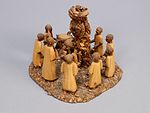Thorn Carving
About this object
History of use
Thorn carvings are miniatures depicting scenes from Nigerian life. This type of carving began circa 1930. Thorns vary in size. They can be as large as 12.7 cm. long and 9.6 cm. wide. They are comparatively soft and easily carved. The light yellow-brown thorn and the dark brown thorn come from the Ata tree; the light red-brown thorn comes from Egun trees. The parts are glued together with viscous paste made from rice cooked with water. They are carved by men.
Narrative
This scene depicts the tree ceremony.
Cultural context
craft; tourist art
Physical description
Nine bareheaded standing figures representing people. Eight are robed and five are holding rolled cloth objects in their right hand. The ninth figure is wearing a shirt, and pants, and is playing two conical shaped drums (membranophone) resting on the ground. Figures are encircling a tall, masked form decorated with headdress, horned-shaped objects, and thorn bush shavings. In front, there is a round table with seven horn-shaped objects, and thornbush shavings decorating the base of drums. Heads, limbs, mask, and three horns are dark brown. Robes, three horns, and head of drums are light yellow-brown. The drummers' shirts, pants, the spiral carved objects, table, centrepiece, and two horns are light red-brown. The wood base is covered with variegated thornbush shavings.
Categories
Date Made
Before 1972
Date Acquired
8 Feb 1980
How Acquired
Donated
Credit Line
Measurements
Overall: 13 cm x 16.5 cm x 15 cm
Object Number
Af350
